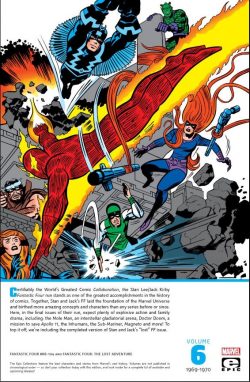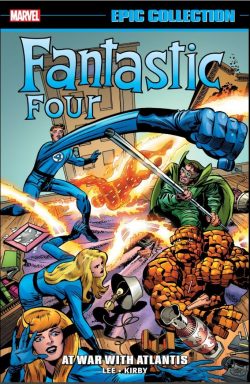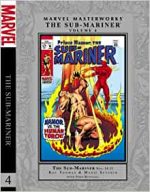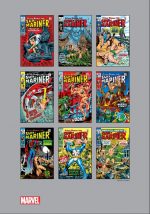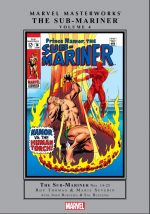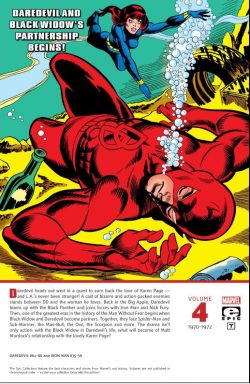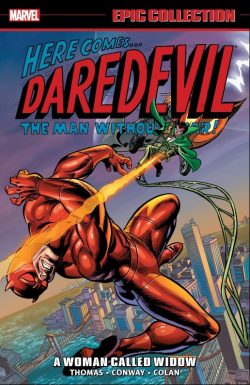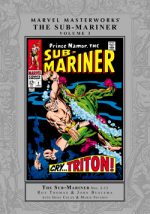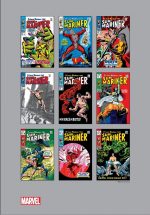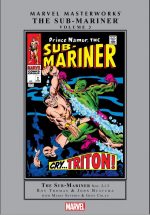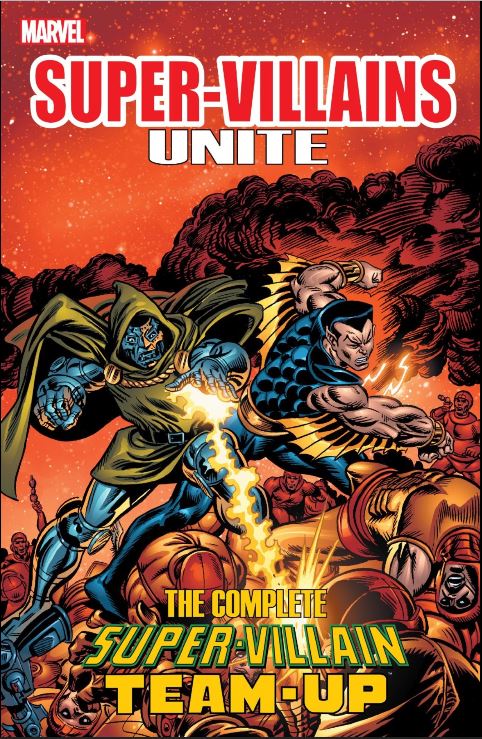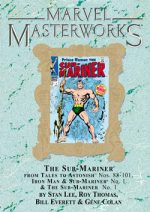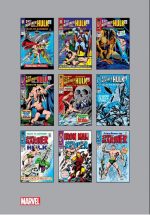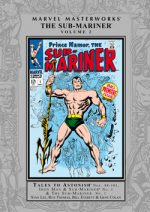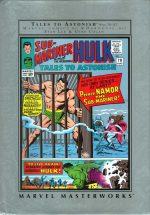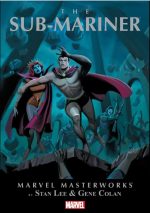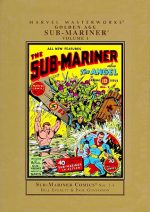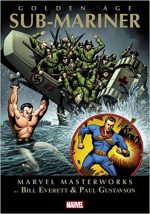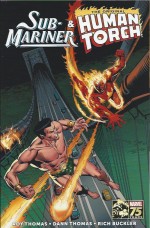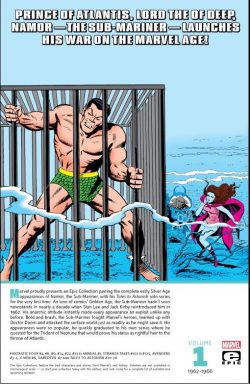
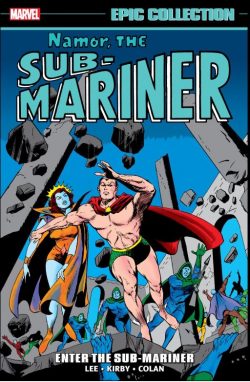
By Stan Lee & Jack Kirby, Larry Lieber, Gene Colan, Dick Ayers, Wallace Wood & various (Marvel)
ISBN: 978-1-3029-2836-0 (TPB)
Prince Namor, the Sub-Mariner is the offspring of a water-breathing Atlantean princess and an American polar explorer: a hybrid being of immense strength; highly resistant to physical harm; able to fly and exist above and below the waves. Created by young, talented Bill Everett, Namor technically predates Marvel/Atlas/Timely Comics.
He first caught the public’s attention as part of the fire vs. water headlining team in Marvel Comics #1 (October 1939 and soon to become Marvel Mystery Comics). He shared honours and top billing with The Human Torch, but had originally been seen (albeit in a truncated monochrome version) in Motion Picture Funnies: a promotional giveaway handed out to moviegoers earlier in the year.
Quickly becoming one of the company’s biggest draws, Namor gained his own title at the end of 1940 (cover-dated Spring 1941) and was one of the last super-characters to go at the end of the first heroic age.
In 1954, when Atlas (as the company then was) briefly revived its costumed character “Big Three†(the Torch and Captain America being the other two), Everett returned for a run of superb fantasy tales, but even so the time wasn’t right and the title sunk again.
When Stan Lee & Jack Kirby started reinventing comic-books in 1961 with the Fantastic Four, they revived the all-but-forgotten awesome amphibian as a troubled, semi-amnesiac, and decidedly more regal, if not grandiose, antihero. The returnee despised humanity; embittered at the loss of his sub-sea kingdom (seemingly destroyed by American atomic testing) whilst simultaneously besotted with the FF‘s Sue Storm.
Namor knocked around the budding Marvel universe for a few years, squabbling with other assorted heroes such as the Hulk, Avengers and X-Men, before securing his own series as one half of Tales to Astonish.
Marvel’s “split-books†had been devised as a way to promote their burgeoning stable of stars whilst labouring under a highly restrictive distribution deal limiting the number of titles they could release per month. In 1968 the company ended this commitment and expanded exponentially.
This first celebratory volume – available in trade paperback and eBook formats collects all those early 1960’s guest shots in one tumultuous tome. Here you’ll find Fantastic Four # 4, 6, 9, 14, 27, 33 and Annual #1; Strange Tales #107 & 125; Avengers #3-4; X-Men #6, Daredevil #7 and the first arc of his own series from Tales to Astonish #70-76. These span May 1962 – February 1966 and open without preamble on that fateful first encounter in this cataclysmic clutch of curated classics…
Crafted by Lee Kirby & Sol Brodsky, Fantastic Four #4 proudly shouted ‘The Coming of the Sub-Mariner’, reintroducing (or introducing) the all-powerful amphibian Prince of Atlantis. The star of Timely’s Golden Age had been lost since 1955 – almost a lifetime for the kids believed to be the prime consumer of comics.
A victim of amnesia, the relic recovers his memory thanks to some rather brusque treatment by teen delinquent and AWOL Human Torch Johnny Storm. Namor rapidly returns to his sub-sea home only to find it destroyed by atomic testing. A monarch without subjects, he swears vengeance on humanity and attacks New York City with a gigantic monster. After its demise amidst a mass of collateral destruction, Sub-Mariner espies and falls for the Invisible Girl: a fascination that will fuel many a monumental battle…
This saga is when the Fantastic Four series truly kicked into high-gear and Reed Richards was the star of the pin-up section reprinted here…
FF #5 debuted the diabolical Doctor Doom who returned in the next issue after duping and teaming up with a reluctant Sub-Mariner to attack the quarrelsome quartet heroes as ‘The Deadly Duo!’ – inked by new regular embellisher Dick Ayers.
Issue #9 declared ‘The End of the Fantastic Four’ as Sub-Mariner Prince Namor returns to exploit another brilliant innovation in comic storytelling. When had a super-genius superhero ever messed up so much that the team had to declare bankruptcy? When had costumed crimefighters ever had money troubles at all? The eerily prescient solution was to “sell out†and make a blockbuster movie – giving Kirby a rare chance to demonstrate his talent for caricature…
Of course, Sub-Mariner’s film project is simply a ruse to divide and conquer and everything is settled with bombastic action and typically off-kilter romantic twist…
The saga is topped off with a Fantastic Four Feature Page explaining ‘How the Human Torch Flies!’
By this time kid-friendly teen Johnny Storm had been awarded a solo-starring lead series in former mystery anthology Strange Tales. Scripted by Larry Lieber and limned by Ayers, #107 featured a splendidly mindless punch-up with the ‘Sub-Mariner’ – a tale powerfully reminiscent of the spectacular and immensely popular Golden Age battles of their publishing forebears.
It’s back to Fantastic Four next as #14 (Lee, Kirby & Ayers) features the return of ‘The Sub-Mariner and the Merciless Puppet Master!’: with one vengeful fiend the unwitting mind-slave of the other, after which 1963’s Fantastic Four Annual #1 offers a spectacular 37-page epic battle as, finally reunited with their wandering prince, the warriors of Atlantis invade New York City and the rest of the world in ‘The Sub-Mariner versus the Human Race!’ by Lee, Kirby & Ayers.
A monumental tale by the standards of the time, the saga saw the FF repel the undersea invasion through valiant struggle and brilliant strategy, and includes the secret history of the secretive race Homo Mermanus. Nothing is really settled except a return to the original status quo, but the thrills are intense and unforgettable…
Also included is a rousing pin-up of Namor from ‘A Gallery of the Fantastic Four’s Most Famous Foes!’.
By now Marvel had many more superheroes and Namor met some in Avengers #3. In the previous issue, the volatile Hulk quit the nascent team in disgust, only to return here as an outright villain in partnership with ‘Sub-Mariner!’ (by Lee, Kirby & Paul Reinman). This globe-trotting romp delivers high-energy thrills and one of the best battle scenes in comics history as the assorted titans clash in abandoned World War II tunnels beneath the Rock of Gibraltar.
Inked by George Roussos, Avengers #4 was a groundbreaking landmark as Marvel’s greatest Golden Age sensation returned in another increasingly war-torn era. ‘Captain America joins the Avengers!’ has everything that made the early tales so fresh and vital. The majesty of a legendary warrior returned in our time of greatest need: stark tragedy in the loss of his boon companion Bucky, aliens, gangsters, the menacing majesty of Sub-Mariner and even subtle social commentary capped by vast amounts of staggering Kirby Action.
The creators had hit on a winning formula by including other stars in guest-shots – especially as readers could never anticipate if they would fight with or beside the home team. FF #27 again finds the undersea anti-hero in amorous mood, but after abducting Sue, he finds the boys have called in called in Doctor Strange, Master of the Mystic Arts to aid them in ‘The Search for Sub-Mariner!’
Delivered by Lee & Kirby, X-Men #6 features ‘Sub-Mariner Joins the Evil Mutants!’: a self-explanatory tale of gripping intensity elevated to magical levels of artistic quality as superbly slick inker Chic Stone adds crisp clarity to proceeding when potential mutant Namor is duped into joining malevolent Magneto and his sinister brotherhood. The issue also incorporates a stunning ‘Special Pin-up page’ starring “Cyclopsâ€.
Impetus was building and support growing for renewed sub-sea skirmishes starring Namor, and Strange Tales #125 (October 1964) presented another bombastic battle between the old adversaries as the Torch and Thing picked a fight with the sea lord in ‘The Sub-Mariner Must Be Stopped!’ courtesy of Lee, Ayers & Reinman.
The princely PR campaign then blossomed into unlikely alliance as FF #33 saw the team ‘Side-by-Side with Sub-Mariner!’ (Lee, Kirby & Stone): bringing the aquatic antihero one step closer to his own series as they lend surreptitious aid to the embattled undersea monarch against deadly barbarian Attuma and supplemented by a glorious Kirby & Stone ‘Prince Namor Pin-up’.
As previously stated, prior to Tales to Astonish, Namor appeared in numerous titles as guest villain du jour. One last guest shot with Namor acting as a misunderstood bad-guy was Daredevil #7 (April 1965): a tale that qualifies as a perfect comic book and a true landmark – to my mind one of the Top Ten Marvel Tales of all Time.
Here, Lee and creative legend Wally Wood concocted a timeless masterpiece with ‘In Mortal Combat with… Sub-Mariner!’ as Prince Namor of Atlantis – recently reunited with the survivors of his decimated race – returns to the surface world to sue mankind for their crimes against his people. To expedite his claim, the Prince engages the services of Matt Murdock‘s law firm; little suspecting the blind lawyer is also the acrobatic Man without Fear.
Whilst impatiently awaiting a hearing at the UN, Namor is informed by his lover Lady Dorma that his warlord Krang has stolen the throne in his absence. The tempestuous monarch cannot languish in a cell when the kingdom is threatened, so he fights his way to freedom through the streets of New York, smashing battalions of National Guard and the dauntless Daredevil with supreme ease.
The hopelessly one-sided battle with one of the strongest beings on the planet shows the dauntless courage of DD and the innate nobility of a “villain†far more complex than most of the industry’s usual fare at the time.
Augmented by a rejected Wood cover repurposed as ‘A Marvel Masterwork pin-up: Namor and D.D.’ this yarn is merely a cunning prequel…
A few months later Tales to Astonish #70 heralded ‘The Start of the Quest!’ as Lee, Gene Colan (in the pseudonymous guise of Adam Austin) & Vince Colletta set the Sub-Mariner to storming an Atlantis under martial law. The effort is for naught and the returning hero is rejected by his own people. Callously imprisoned, the troubled Prince is freed by the oft-neglected and ignored Lady Dorma…
As the pompous hero begins a mystical quest to find the lost Trident of King Neptune – which only the rightful ruler of Atlantis can hold – he is unaware that treacherous Krang allowed him to escape, the better to destroy him with no witnesses…
The serialised search carries Namor through a procession of fantastic adventures and pits him against a spectacular array of sub-sea horrors: a giant octopus in ‘Escape… to Nowhere’; a colossal seaweed man in ‘A Prince There Was’ and a demented wizard and energy-sapping diamonds in ‘By Force of Arms!’
As the end approaches in ‘When Fails the Quest!’, revolution grips Atlantis, and Namor seemingly sacrifices his kingdom to save Dorma from troglodytic demons the Faceless Ones.
In issue #75 ‘The End of the Quest’ finds the Prince battling his way back into Atlantis with a gravely-injured Dorma, before the saga calamitously concludes in ‘Uneasy Hangs the Head…!’ with the status quo restored, Namor again on the stolen throne and further danger and drama to come…
Supplemented with House ads, a full cover gallery, unseen, unused and original artwork pages and more, this assemblage of tales feature some of Marvel’s very best artists at their visual peak, with creative verve and enthusiasm shining through.
Perhaps more vicarious thrill than fan’s delight, many early Marvel Comics are more exuberant than qualitative, but this volume, especially from an art-lover’s point of view, is a wonderful exception: a historical treasure that fans will find irresistible.
© 2021 MARVEL.

